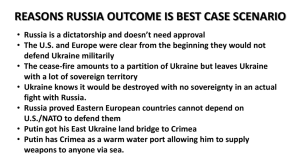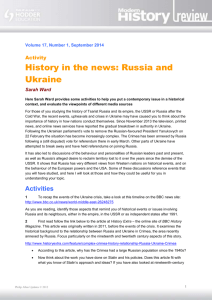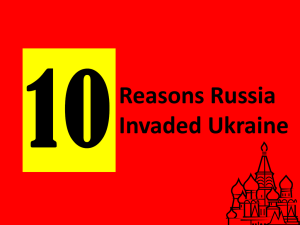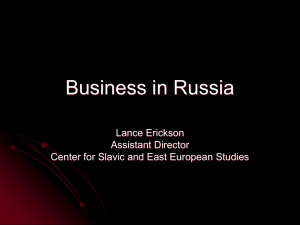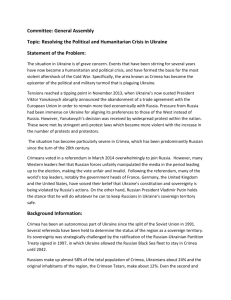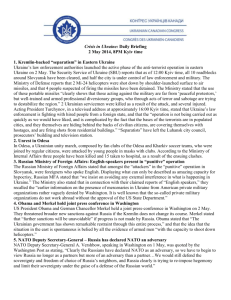Crisis in Ukraine - Case of Crimea
advertisement
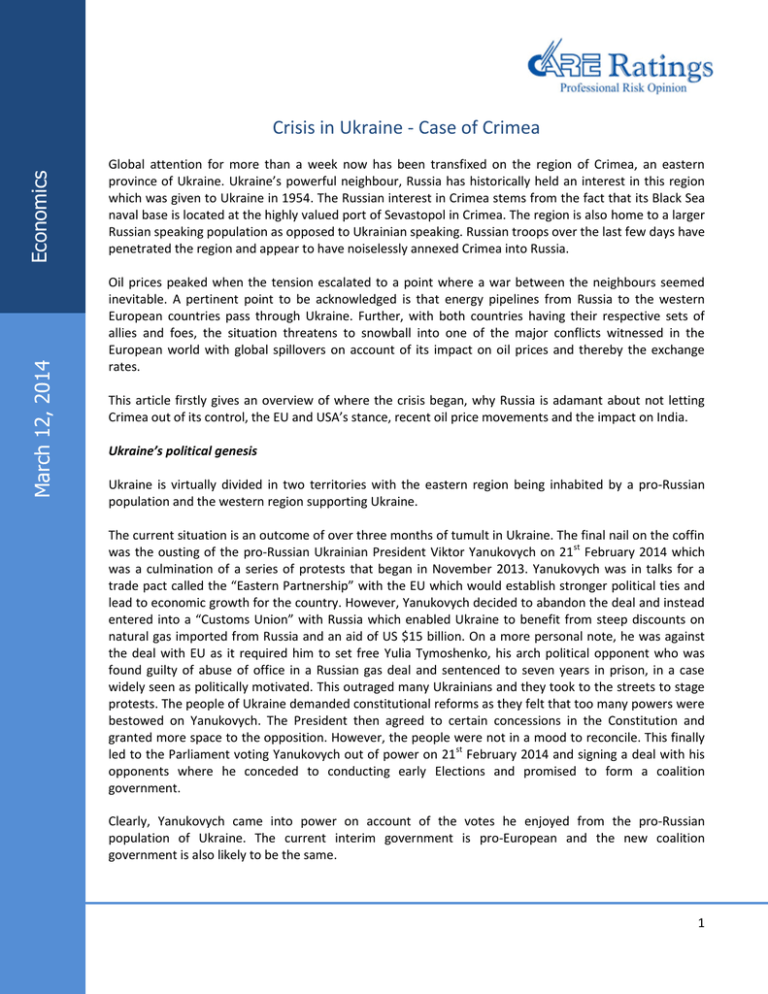
March 12, 2014 Economics Crisis in Ukraine - Case of Crimea Global attention for more than a week now has been transfixed on the region of Crimea, an eastern province of Ukraine. Ukraine’s powerful neighbour, Russia has historically held an interest in this region which was given to Ukraine in 1954. The Russian interest in Crimea stems from the fact that its Black Sea naval base is located at the highly valued port of Sevastopol in Crimea. The region is also home to a larger Russian speaking population as opposed to Ukrainian speaking. Russian troops over the last few days have penetrated the region and appear to have noiselessly annexed Crimea into Russia. Oil prices peaked when the tension escalated to a point where a war between the neighbours seemed inevitable. A pertinent point to be acknowledged is that energy pipelines from Russia to the western European countries pass through Ukraine. Further, with both countries having their respective sets of allies and foes, the situation threatens to snowball into one of the major conflicts witnessed in the European world with global spillovers on account of its impact on oil prices and thereby the exchange rates. This article firstly gives an overview of where the crisis began, why Russia is adamant about not letting Crimea out of its control, the EU and USA’s stance, recent oil price movements and the impact on India. Ukraine’s political genesis Ukraine is virtually divided in two territories with the eastern region being inhabited by a pro-Russian population and the western region supporting Ukraine. The current situation is an outcome of over three months of tumult in Ukraine. The final nail on the coffin was the ousting of the pro-Russian Ukrainian President Viktor Yanukovych on 21st February 2014 which was a culmination of a series of protests that began in November 2013. Yanukovych was in talks for a trade pact called the “Eastern Partnership” with the EU which would establish stronger political ties and lead to economic growth for the country. However, Yanukovych decided to abandon the deal and instead entered into a “Customs Union” with Russia which enabled Ukraine to benefit from steep discounts on natural gas imported from Russia and an aid of US $15 billion. On a more personal note, he was against the deal with EU as it required him to set free Yulia Tymoshenko, his arch political opponent who was found guilty of abuse of office in a Russian gas deal and sentenced to seven years in prison, in a case widely seen as politically motivated. This outraged many Ukrainians and they took to the streets to stage protests. The people of Ukraine demanded constitutional reforms as they felt that too many powers were bestowed on Yanukovych. The President then agreed to certain concessions in the Constitution and granted more space to the opposition. However, the people were not in a mood to reconcile. This finally led to the Parliament voting Yanukovych out of power on 21st February 2014 and signing a deal with his opponents where he conceded to conducting early Elections and promised to form a coalition government. Clearly, Yanukovych came into power on account of the votes he enjoyed from the pro-Russian population of Ukraine. The current interim government is pro-European and the new coalition government is also likely to be the same. 1 Economics Russia’s interest in Crimea With the developments in Ukraine, Russia openly claimed that the “Russian speaking” population of the country were put in minority and had no say in the developments in the country. President Putin went on to record to say that the “Russians” in Ukraine were denied their human rights and this invoked his interest in safeguarding the rights and interests of his people (inhabitants of Crimea). While this statement does not appear to be overtly incorrect as Putin was concerned about the future of Crimea, there is a deeper point. The lease of the port of Sevastopol which is the Russian Black Sea naval base expires in 2017. When Yanukovych was in power, he had agreed to extend the lease. However, if a coalition Government is formed it is more likely that the lease will not be renewed which implies that President Putin would have to withdraw his base from the strategically located Sevastopol. This led to the President mobilizing forces. However a larger risk of war was against his interest given that gas pipelines to Europe run through Ukraine. This explains the peaceful takeover of the port of Sevastopol by the Russian forces. How did the EU respond? The European Union is Russia’s third largest trading partner. Likewise, Russia is EU’s third largest trading partner after USA and China. Close to 75% of all Foreign Direct Investment (FDI) in Russia originates in EU member countries, according to the European Commission. In addition, Russia is the largest energy provider to the EU countries. Hence, the last thing EU wants is a war in its own backyard. o Major countries of the EU namely Germany and United Kingdom have engaged in diplomatic talks with Russia hoping to end the conflict by means of dialogue primarily. o Further, the European Union announced to offer Ukraine at least $15 billion in aid. This package would provide Ukraine with assistance over the next few years. o EU has also announced temporary reduction on duties on Ukrainian imports. o Closer proximity to Russia and crucial economic ties make the issue of sanctions more difficult for European countries. Already, Russia threatens to retaliate with its own sanctions if the United States and Europe take such a step. Hence, providing financial aid is the easiest and most immediate way for the EU to extend support to Ukraine without running into the risk of showing excessive support. How did the USA respond? The economic relationship between Russia and the U.S. is largely unbalanced. Russia is the 20th largest trading partner for the U.S., with $27 billion worth of trade exported to Russia. On the flip-side, the U.S. is Russia's fifth largest partner, with just $11 billion worth of trade. USA is not dependent on Russia for energy related reasons as well as it has moved towards “self-sufficiency”. o o o US openly condemned the act of forceful annexation by Russia with continued efforts in resolving the conflict by diplomatic dialogue. The USA has already issued visa bans for certain Russian and Ukrainian individuals who were responsible for threatening the sovereignty and integrity of Ukraine. In addition, President Obama also signed an executive order which provides the legal framework and basis for sanctions against specific people and entities. Crisis in Ukraine - Case of Crimea 2 Economics o o Secretary of State John Kerry announced $1 billion in loan guarantees for Ukraine as part of the Obama administration's effort to publicly support the interim government of Ukraine and provide incentive for Ukraine to continue to align itself with the West through the European Union instead of Russia. The United States also seeks to isolate Russia diplomatically by joining other members of the G8 group of industrial powers in pulling out of preparatory meetings for the scheduled June summit in Sochi, Russia. The foundation of the U.S. stance is for Ukraine to maintain its independence and territorial integrity, while also recognizing Russia's historical and economic ties to Ukraine. The Eurozone is fragile as it has freshly emerged from its own crisis and at such a juncture it would be wary of cutting ties with an international superpower and major trade partner. Its reliance on Russia for energy will also induce caution. In contrast, the U.S. is weaning itself off Russia's energy supplies and its trade relationship is much less intertwined and hence has been in a position to be sterner on Russia. However, as per the latest news, USA, UK and EU countries have agreed to force a travel ban and freeze the assets of some Russians who have been instrumental in the crisis unless Russia resolves the military standoff in the Black Sea region. Oil price movements Oil prices have spiked up since the crisis commenced with concerns of oil outflows from Russia. Oil (WTI) and Brent prices have got elevated. The exhibit below depicts the movements in oil prices from 2nd February 2014 to 10th March 2014. Exhibit 1: Oil (WTI) and Oil (Brent) from 2nd Feb '14 to 10th Mar '14 115.00 110.00 105.00 100.00 95.00 Oil (WTI) Crisis in Ukraine - Case of Crimea 3/9/2014 3/7/2014 3/5/2014 3/3/2014 3/1/2014 2/27/2014 2/25/2014 2/23/2014 2/21/2014 2/19/2014 2/17/2014 2/15/2014 2/13/2014 2/11/2014 2/9/2014 2/7/2014 2/5/2014 90.00 Oil (Brent) 3 Economics o o West Texas Intermediate (WTI) in particular has crossed the $100 a barrel mark. It has increased from $ 96.46 on 2nd February 2014 to $ 101.12 on 10th March 2014. It was the highest at $ 104.92 on 3rd March when the geopolitical tension between the countries was at its peak. Brent has also remained high post the crisis. Brent prices were the highest on 3rd March 2014 at $111.20 a barrel. Since 6th March however, oil prices have remained largely stable with WTI maintaining its level at around $101 a barrel and Brent at around $108 a barrel. With the conflict still being far from resolved, it remains to be seen where oil prices finally settle. Impact on global markets o o o So far markets appear to remain resilient to the on-going conflicts while reacting only to economic data. Markets have historically displayed the characteristic to respond only when there is a clear decisive outcome. So far, the conflict remains unresolved. However, the trouble is that if a civil war breaks out in Ukraine (less likely) this would have a greater impact on European and global economies and markets. Impact on India India’s trade with the two concerned countries accounts for only a small fraction of India’s overall trade basket. Hence, the balance of payment position of the country should not suffer as a consequence of this conflict. o India’s export to Russia was worth US $2,295.681 mn in FY13 amounting to only 0.76% share of India’s total exports. The cumulative exports for FY14 as of Dec ‘13 stand at US $ 1,586.45 mn which contributes only 0.69% to India’s total exports for the year so far. o The imports from Russia were US $ 4,231.56 mn in FY13. The same stand at $ 2,984.38 from April to December ‘13 occupying only 0.88% share of the total imports. o India’s trade with Ukraine is far less significant. Exports to Ukraine occupy a share of only 0.17% in FY13 and 0.16% in FY14 (up to Dec ’13). Imports from Ukraine stood at $ 2,657.47 mn in FY13 (0.54% of total) and are currently at $ 1,353.55 mn (0.40% of total imports) as of December ’13. The stock markets have not quite reacted to this crisis as it has been dominated more by domestic news. The same has been the case with interest rates too. Hence, it does appear that India has not been affected by the crisis in Ukraine. 1 Data on India’s foreign trade is from the Ministry of Commerce Crisis in Ukraine - Case of Crimea 4 Economics Any concerns? The two major concerns for India are on the movement in oil prices and the volatility in the exchange rate. Higher oil prices have put pressure on the import bill, but a delayed resolution of the problem will exacerbate the situation. Presently our import bill is under control with curbs being put on gold imports. Further, an industrial slowdown has lowered demand for non-oil-gold imports. Persistence of high oil prices would hence not be favourable for the CAD. The exchange rate has been stable in the last three months due to the steps taken by the RBI along with improvement in fundamentals. However, if the problem was to persist then it could make exchange rates across the globe volatile affecting also the flow of funds hence having a collateral effect on emerging markets including India. However, it is expected that the situation will not snowball into a crisis like situation and the impact on crude oil prices, funds flows and exchange rates would be limited and time bound. Contact: Madan Sabnavis Chief Economist madan.sabnavis@careratings.com 91-022-67543489 Garima Mehta Associate Economist garima.mehta@careratings.com Disclaimer This report is prepared by the Economics Division of Credit Analysis & Research Limited [CARE]. CARE has taken utmost care to ensure accuracy and objectivity while developing this report based on information available in public domain. However, neither the accuracy nor completeness of information contained in this report is guaranteed. CARE is not responsible for any errors or omissions in analysis/inferences/views or for results obtained from the use of information contained in this report and especially states that CARE (including all divisions) has no financial liability whatsoever to the user of this report. Crisis in Ukraine - Case of Crimea 5


